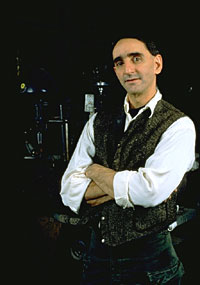|
|
|
||||||
|
|
|||||||
|
Gregory BARSAMIAN generates three-dimensional animation by linking together finely wrought sculptures and revolving them by motor under simultaneously flashing strobe lights. As the images rapidly change at several joints in the sequence, they are cyclically repeated. For instance, <<Putti>>(1991) repeats the metamorphoses between an angel and a helicopter; in <<Dipping Digits>>(1992) a hand scoops a lizard from the text of an open book; and in <<Feral Fount>>(1996) drops of water trickling from a water faucet metamorphose into a bomb, which passes through the hand like water to become a paper airplane that breaks a ceramic dish. These sequential, meditative images lead us on a journey to the subconscious. If dreams are the wellspring of images for the artist, then the artist's work certainly overlaps with the interpretation of those dreams. |
 |
|
|
The technique of BARSAMIAN's animation has its origins in the zoetrope, a spinning optical toy, the development of which forms part of the prehistory of cinema. By the 1880s, Etienne-Jules MAREY had already produced a stereographic zoetrope. The early animation technique preceding this, such as flipbooks and the phenakistiscope discs, also possessed a feeling of presence that differs from the light images seen on a CRT, forming a wellspring of creativity for other contemporary moving image artists as well, such as IWAI Toshio. But unlike IWAI, who sees a starting point for the interactivity of visual devices in the connection between sight and the hand that flips paper or spins a drum, BARSAMIAN uses the machine to revolve images, and he does not actively seek the bodily movement of the viewers. And yet BARSAMIAN does make his work on a scale larger than the human body, and by enveloping the viewer in the flashing light of a strobe, his work contemplates the body within space from a different angle. The metamorphoses of his work are not peeped into from a real external space; rather, they are revealed to us from within the overall space that simultaneously "envelops" both the body and the work. At that point, the body of the viewer has already shifted into another mode that differs from real space.
(KAMIKANDA Kei, ICC)
|
||